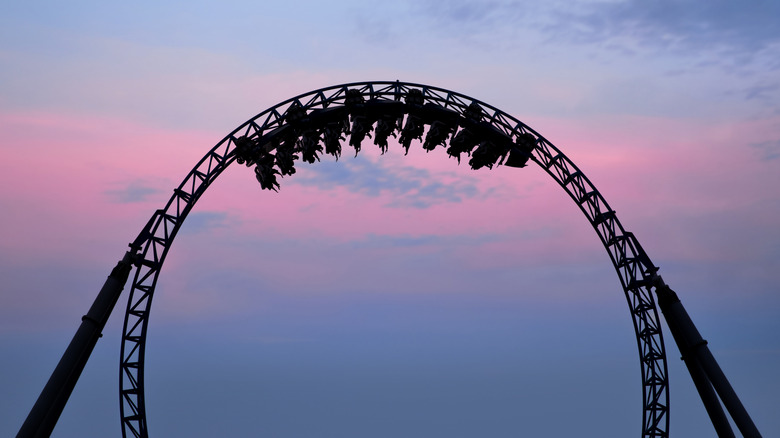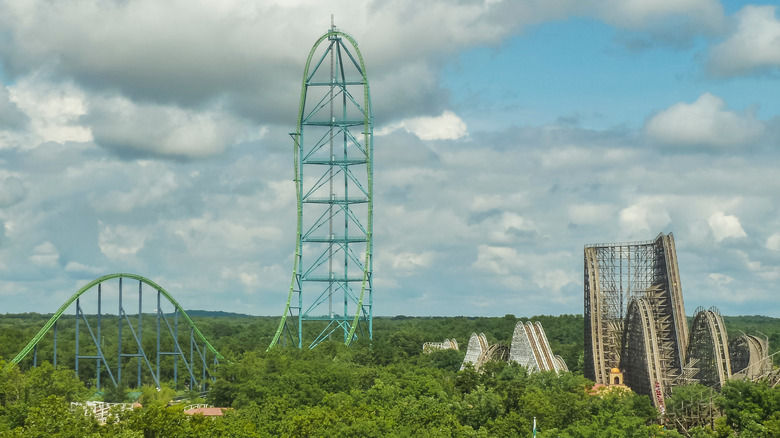Euthanasia Coaster: The Roller Coaster Designed To Kill You
Have you ever had so much fun you could die? How about literally? Roller coasters are already terrifying enough, but one hypothetical "Euthanasia Coaster" is mathematically designed to kill every single one of its passengers.
The Euthanasia Coaster comes to us courtesy of Julijonas Urbonas, founder of the Lithuanian Space Agency and eccentric polymath "informed by postphenomenology, space medicine, particle physics, outer space anthropology, extro-disciplinarity," and more, as his personal website (and its very telltale design) says. Part thought experiment, part actual proposal to anyone who might step up to the plate, Urbonas built a scale model of his Euthanasia Coaster when he was a Ph.D. student in 2010 at London's Royal College of Art. The goal, per Penn Live, was to create "a hypothetic death machine in the form of a roller coaster, engineered to humanely — with elegance and euphoria — take the life of a human being."
On Urbonas' Euthanasia Coaster page, he explains that he took inspiration from John Allen, former president of the famed Philadelphia Toboggan Company, who said that "the ultimate roller coaster is built when you send out 24 people and they all come back dead." To Urbonas, who's really into his whole mad artist vibe, the Euthanasia Coaster is "a prop for non-existent horror movie, a real fiction, a black humor scenography, social sci-fi design, the world's most extreme ride, a mourning sculpture, a monument for the end of the carousel evolution, a gravitational weapon, the very last trip."
Death by g-force
Many might be wondering exactly how a roller coaster could kill someone. But if the reader imagines all the body's blood and oxygen getting compressed and hurled around, it's not too hard to figure out the cause of death: g-forces. As Science Explorer says, creator Julijonas Urbonas did some careful math to ensure that riders hit 10 Gs during the Euthanasia Coaster's three-minute duration — that's 10 times the normal gravity of Earth. For comparison, astronauts normally hit about 3 Gs maximum during a rocket launch, per SpaceAnswers. At 9 Gs, blood can't reach the brain. And so, as a very menacing trailer for the short 2015 film H Positive says — a film based on the Euthanasia Coaster and co-written by Urbonas — the brain experiences "prolonged cerebral hypoxia."
The Science Explorer says that 24 riders can reach their final decision during the climb to the top of the Euthanasia Coaster's 1,600-foot-tall drop, and somehow exit at that point if they choose not to go through with it. The drop sends them plummeting at 223 miles per hour into the first of seven loop-de-loops, each smaller than the one before it, which pin riders to their seats and flood their legs with blood. The loop section lasts one minute, and that's more than enough to kill someone. Urbonas calls it a "humane" death full of "elegance and euphoria," although it's questionable that's what onlookers would see while staring up at carts full of limp and contorted bodies.
Euphoria, terror, or both?
If you haven't guessed by now, the Euthanasia Coaster's designer Julijonas Urbonas is pretty enamored with his death ride, as he seems to be about all his ideas (judging by his personal website). On The Science Explorer, he describes his invention in vivid, glowing terms, saying that it would transform death into a beautiful, transcendent experience. "It would be a meaningful death," he says, continuing, "For the caller, it is a painless, whole-body engaging and ritualized death machine." However, there's no discussion of any of the ride's practicalities anywhere: cost, materials, location, forms to sign, legal disposal of all the bodies that slide to a halt at the end of the ride, and so on. Those things might add to riders' distress and panic as they're climbing to the top of the ride, and countermand the supposed bliss of the whole experience.
As far as physical sensations are concerned, we've got "oxygen deficiency," "cerebral suffocation," blurred vision, extreme difficulty breathing, loss of peripheral vision, loss of hearing, "disorientation, anxiety, confusion," and so on — all per Urbonas' own Euthanasia Coaster page. There's also a general loss of consciousness, having a "limp body," "vivid space dreams" like being trapped in a maze, losing your sense of self, and more. Sites like Healthline confirm all these claims in more medical terms, and point out that cerebral hypoxia typically happens when someone is drowning, choking, being poisoned by carbon monoxide, having an asthma attack, etc. In other words, not a good time.
The tallest and the deadliest
As far as physical construction is concerned, the Euthanasia Coaster — actual name pending — isn't too, too outlandish. It just incorporates structural design elements, like seven-in-a-row loop-de-loops, that other designers avoid because they don't want to, you know, kill people. Funeral Wise shows us a scale model of the final, intended coaster design, which we can see just goes straight up really, really far, does a straight drop down in the loops, and then peters out at the end. No corkscrews, no horizontal loops, no dangling customer legs — nothing fancy. We suppose that helps keep the Euthanasia Coaster fixed on its deathly purpose.
The Euthanasia Coaster's size, however, is when we see its ambitiousness on full display. In order to kill people by the first loop — the likely outcome for most — the coaster would have to be three times as tall as the world's tallest current roller coaster, the Kingda Ka at Six Flags in Jackson, New Jersey (pictured above). That coaster — a purely commercial venture belonging to a big entertainment chain, mind you — cost $25 million and finished in 18 months. Such money and time investments might be why Julijonas Urbonas' Euthanasia Coaster never got off the ground (so to speak). That is, aside from all the controversy about assisted suicide. Regardless, Urbonas's mad visions definitely portray Dr. Jack Kevorkian's "death van" and patient self-anaesthenization as a much more modest venture.
Try before you die
And because of course, there's a way to simulate what it's like to ride Julijonas Urbonas' Euthanasia Coaster even though it was never built. We're not talking Oculus Rift VR — don't get too excited — but we are at least talking about videos. Using what might be a video game mod, one enthusiast takes viewers on a first-person YouTube trip up to the top of the coaster and down through its many vertical loops. Bear in mind that riders would be long dead by the time the coaster comes to its gentle, slow stop. LadBible describes yet another simulation crafted by a TikTok user depicting much the same.
The aforementioned short film H Positive, meanwhile, takes us a much more dramatic and grim passage up, down, and around the Euthanasia Coaster via a fictional character who wishes to die. The camera stays locked on his face while he rides, watching it fall limp, slack-jawed, and very, very dead. The film is not for the faint of heart and shouldn't be watched lightly. Actor Roger Barclay does a bang-up job in the main role and really sells the kind of person who seems likely to want to take advantage of the Euthanasia Coaster. If Dr. Kevorkian was for the elderly and those of more modest means, then it stands to reason that Urbonas — especially in an attempt to recoup costs — would attract the precise person depicted in H Positive: wealthy, disaffected, and obsessive.
Ride and survive
Despite all descriptions of Julijonas Urbonas' Euthanasia Coaster and its effects on the human body — death and torment preceding it — some folks are bound to want to try it. Others will believe that they can beat it. They'll believe that through force of will, deep breathing exercises, or just dumb luck they can survive the trek up and around Urbonas' loops of doom and live to tell the tale and maybe take some mid-loop selfies to boot. But is it possible to cheat this particular form of death?
According to LadBible, an aeronautics engineer spoke up during one of Urbonas' exhibitions when Urbonas was showing off the scale model of his death ride. The individual said, "Your machine could be hacked, you know," and continued to explain that it would take nothing more complicated than something called a g-suit. According to Acme Worldwide, g-suits are commonplace, tracksuit-looking outfits worn by people like fighter pilots. They help redistribute pressure across a body experiencing stresses from extra Gs. Such a suit would prevent blood from pooling in the legs and draining from the brain, thereby preventing the cerebral hypoxia that would kill most other riders. These people, and amputees who've already lost limbs, might just survive the Euthanasia Coaster with minimal trouble. This is good news for Urbonas, however. Who else would be waiting in line and ready to become one of his repeat customers?
If you or anyone you know is having suicidal thoughts, please call the National Suicide Prevention Lifeline by dialing 988 or by calling 1-800-273-TALK (8255).




